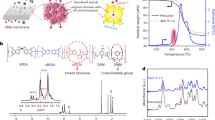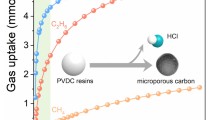Abstract
A carbon molecular sieve (CMS) membrane is a microporous membrane that can serve as a molecular sieve. Tuning the pore size of a CMS membrane to improve the selectivity of desirable gas pair is highly necessary. Herein, we report the first study on the toluene vapor modification of a CMS membrane that shows high H2 selectivity. A commercial polyimide hollow fiber membrane was used as the polymeric precursor, and it was pyrolyzed at different temperatures from 625 to 700 ℃ for up to 120 min in an inert nitrogen atmosphere. Toluene vapor was introduced into the nitrogen stream for different durations (10–50 min) at the final pyrolysis temperature. The permeance of the resulting CMS membranes for H2, CO2, O2, N2, and CH4 gases was evaluated at 35 ℃ under 1 atm pressure. The gas permeance and selectivity could be readily controlled by adjusting the pyrolysis temperature and duration of toluene vapor addition for membrane modification. Upon comparing samples with similar H2 permeances, the toluene-vapor-modified membrane was found to exhibit a higher selectivity for H2/CO2, H2/N2, and H2/CH4. This could not be realized simply by increasing the pyrolysis temperature without toluene vapor addition. For instance, a CMS membrane pyrolyzed at 675 ℃ with 20 min of toluene vapor addition showed H2/CH4 selectivity of 4200 and H2 permeance of 270 GPU, while a CMS membrane pyrolyzed at 700 ℃ without using toluene vapor showed a lower H2/CH4 selectivity of 1100 and a similar H2 permeance of 250 GPU. The optimal pyrolysis conditions of the CMS membrane subjected to toluene vapor modification depend on the targeted gas pair. The proposed toluene vapor modification process can be used as a simple and effective additional treatment for the preparation of CMS membranes.










Similar content being viewed by others
References
Y. Wu, J. Xu, K. Mumford, G.W. Stevens, W. Fei, Y. Wang, Recent advances in carbon dioxide capture and utilization with amines and ionic liquids. Green. Ch. E. 1(1), 16–32 (2020). https://doi.org/10.1016/j.molliq.2021.117080
N.W. Ockwig, T.M. Nenoff, Membranes for hydrogen separation. Chem. Rev. 107, 4078–4110 (2007). https://doi.org/10.1021/cr0501792
R.W. Spillman, Economics of gas separation membranes. Chem. Eng. Prog. 85, 41–62 (1989)
B.D. Freeman, Basis of permeability/selectivity tradeoff relations in polymeric gas separation membranes. Macromolecules 32(2), 375–380 (1999). https://doi.org/10.1021/ma9814548
A.F. Ismail, L.I.B. David, A review on the latest development of carbon membranes for gas separation. J. Membr. Sci. 193(1), 1–18 (2001). https://doi.org/10.1016/S0376-7388(01)00510-5
P.-S. Lee, D. Kim, S.-E. Nam, R.R. Bhave, Carbon molecular sieve membranes on porous composite tubular supports for high performance gas separations. Microporous Mesoporous Mater. 224, 332–338 (2016). https://doi.org/10.1016/j.micromeso.2015.12.054
J. Koresh, A. Soffer, Molecular sieve carbon permselective membrane. Part I. Presentation of a new device for gas mixture separation. Sep. Sci. Technol. 18, 723–734 (1983). https://doi.org/10.1080/01496398308068576
J. Koresh, A. Soffer, The carbon molecular sieve membranes. General properties and the permeability of CH4/H2 mixture. Sep. Sci. Technol. 22, 973–982 (1987). https://doi.org/10.1080/01496398708068993
O. Karvan, J.R. Johnson, P.J. Williams, W.J. Koros, A pilot-scale system for carbon molecular sieve hollow fiber membrane manufacturing. Chem. Eng. Technol. 36(1), 53–61 (2013). https://doi.org/10.1002/ceat.201200503
M. Yoshimune, K. Haraya, An approach toward the practical use of carbon membranes in gas separation processes. Membrnae 43(4), 137–141 (2018). https://doi.org/10.5360/membrane.43.137
V.C. Geiszler, W.J. Koros, Effects of polyimide pyrolysis conditions on carbon molecular sieve membrane properties. Ind. Eng. Chem. Res. 35(9), 2999–3003 (1996). https://doi.org/10.1021/ie950746j
M. Kiyono, P.J. Williams, W.J. Koros, Effect of polymer precursors on carbon molecular sieve structure and separation performance properties. Carbon 48(15), 4432–4441 (2010). https://doi.org/10.1016/j.carbon.2010.08.002
R. Wu, W. Yue, Y. Li, A. Huang, Ultra-thin and high hydrogen permeable carbon molecular sieve membrane prepared by using polydopamine as carbon precursor. Mater. Lett. 295, 129863 (2021). https://doi.org/10.1016/j.matlet.2021.129863
M. Yoshino, S. Nakamura, H. Kita, K. Okamoto, N. Tanihara, Y. Kusuki, Olefin/paraffin separation performance of carbonized membranes derived from an asymmetric hollow fiber membrane of 6FDA/BPDA-DDBT copolyimide. J. Membr. Sci. 215(1–2), 169–183 (2003). https://doi.org/10.1016/S0376-7388(02)00611-7
S. Fu, G.B. Wenz, E.S. Sanders, S.S. Kulkarni, W. Qiu, C. Ma, W.J. Koros, Effects of pyrolysis conditions on gas separation properties of 6FDA/DETDA: DABA (3:2) derived carbon molecular sieve membranes. J. Membr. Sci. 520, 699–711 (2016). https://doi.org/10.1016/j.memsci.2016.08.013
P.S. Tin, T.S. Chung, A.J. Hill, Advanced fabrication of carbon molecular sieve membranes by nonsolvent pretreatment of precursor polymers. Ind. Eng. Chem. Res. 43(20), 6476–6483 (2004). https://doi.org/10.1021/ie049606c
J. Hayashi, H. Mizuta, M. Yamamoto, K. Kusakabe, S. Morooka, Pore size control of carbonized BPDA-pp´ODA polyimide membrane by chemical vapor deposition of carbon. J. Membr. Sci. 124(2), 243–251 (1997). https://doi.org/10.1016/S0376-7388(96)00250-5
S. Haider, A. Lindbråthen, J.A. Lie, I.C.T. Andersen, M.-B. Hägg, CO2 separation with carbon membranes in high pressure and elevated temperature applications. Sep. Purif. Technol. 190, 177–189 (2018). https://doi.org/10.1016/j.seppur.2017.08.038
M. Yoshimune, K. Haraya, Simple control of the pore structures and gas separation performances of carbon hollow fiber membranes by chemical vapor deposition of propylene. Sep. Purif. Technol. 223, 162–167 (2019). https://doi.org/10.1016/j.seppur.2019.04.065
H.B. Park, Y.K. Kim, J.M. Lee, S.Y. Lee, Y.M. Lee, Relationship between chemical structure of aromatic polyimides and gas permeation properties of their carbon molecular sieve membranes. J. Membr. Sci. 229(1–2), 117–127 (2004). https://doi.org/10.1016/j.memsci.2003.10.023
L.I.B. David, A.F. Ismail, Influence of thermastabilization process and soak time during pyrolysis process on the polyacrylonitrile carbon membranes for O2/N2 separation. J. Membr. Sci. 213(1–2), 285–291 (2003). https://doi.org/10.1016/S0376-7388(02)00513-6
D.Q. Vu, W.J. Koros, S.J. Miller, High pressure CO2/CH4 separation using carbon molecular sieve hollow fiber membranes. Ind. Eng. Chem. Res. 41(3), 367–380 (2002). https://doi.org/10.1021/ie010119w
M. Heinrich, H. Heinrich, K. Werner, P. Werner, J. Harald, K. Karl, Z. Dieter, Carbon containing molecular sieves. US Patent 3979330-A (1976).
Y. Kawabuchi, H. Oka, S. Kawano, I. Mochida, N. Yoshizawa, The modification of pore size in activated carbon fibers by chemical vapor deposition and its effect on molecular sieve selectivity. Carbon 36(4), 377–382 (1998). https://doi.org/10.1016/S0008-6223(97)00186-3
S. Villar-Rodil, R. Denoyel, J. Rouquerol, A. Martínez-Alonso, J.M.D. Tascón, Fibrous carbon molecular sieves by chemical vapor deposition of benzene. Gas separation ability. Chem. Mater. 14(10), 4328–4333 (2002). https://doi.org/10.1021/cm021193n
J.H. Zhang, S.J. Qu, L.T. Li, P. Wang, X.F. Li, Y.F. Che, X.L. Li, Preparation of carbon molecular sieves used for CH4/N2 separation. J. Chem. Eng. Data 63(5), 1737–1744 (2018). https://doi.org/10.1021/acs.jced.8b00048
T. Horikawa, J. Hayashi, K. Muroyama, Preparation of molecular sieving carbon from waste resin by chemical vapor deposition. Carbon 40(5), 709–714 (2002). https://doi.org/10.1016/S0008-6223(01)00157-9
Y. Yamane, H. Tanaka, M.T. Miyahara, In silico synthesis of carbon molecular sieves for high-performance air separation. Carbon 141, 626–634 (2019). https://doi.org/10.1016/j.carbon.2018.10.021
T. Ogoshi, K. Yoshikoshi, R. Sueto, H. Nishihara, T. Yamagishi, Porous carbon fibers containing pores with sizes controlled at the angstrom level by the cavity size of pillar [6] arene. Angew. Chem. Int. Ed. 54(22), 6466–6469 (2015). https://doi.org/10.1002/anie.201501854
T. Ogoshi, Y. Sakatsume, K. Onishi, R. Tang, K. Takahashi, H. Nishihara, Y. Nishina, B.D.L. Campéon, T. Kakuta, T. Yamagishi, The carbonization of aromatic molecules with three-dimensional structures affords carbon materials with controlled pore sizes at the Ångstrom-Leve. Commun. Chem. 4, 75 (2021). https://doi.org/10.1038/s42004-021-00515-0
K. Okamoto, S. Kawamura, M. Yoshino, H. Kita, Y. Hirayama, N. Tanihara, Y. Kusuki, Olefin/paraffin separation through carbonized membranes derived from an asymmetric polyimide hollow fiber membrane. Ind. Eng. Chem. Res. 38(11), 4424–4432 (1999). https://doi.org/10.1021/ie990209p
P.H.T. Ngamou, M.E. Ivanova, O. Guillon, W.A. Meulenberg, High-performance carbon molecular sieve membranes for hydrogen purification and pervaporation dehydration of organic solvents. J. Mater. Chem. A 7, 7082–7091 (2019). https://doi.org/10.1039/C8TA09504C
H. Richter, H. Voss, N. Kaltenborn, S. Kämnitz, A. Wollbrink, A. Feldhoff, J. Caro, S. Roitsch, I. Voigt, High-flux carbon molecular sieve membranes for gas separation. Angew. Chem. Int. Ed. 56(27), 7760–7763 (2017). https://doi.org/10.1002/anie.201701851
L. Lei, F. Pan, A. Lindbråthen, X. Zhang, M. Hillestad, Y. Nie, L. Bai, X. He, M.D. Guiver, Carbon hollow fiber membranes for a molecular sieve with precise-cutoff ultramicropores for superior hydrogen separation. Nat. Commun. 12, 268 (2021). https://doi.org/10.1038/s41467-020-20628-9
L. Lei, A. Lindbråthen, M. Hillestad, X. He, Carbon molecular sieve membranes for hydrogen purification from a steam methane reforming process. J. Membr. Sci. 627, 119241 (2021). https://doi.org/10.1016/j.memsci.2021.119241
S. Roy, R. Das, M.K. Gagrai, S. Sarkar, Preparation of carbon molecular sieve membrane derived from phenolic resin over macroporous clay-alumina based support for hydrogen separation. J. Porous Mater. 23(6), 1653–1662 (2016)
S.C. Rodrigues, R. Whitley, A. Mendes, Preparation and characterization of carbon molecular sieve membranes based on resorcinol-formaldehyde resin. J. Membr. Sci. 459, 207–216 (2014)
Y. Kusuki, H. Shimazaki, N. Tanihara, S. Nakanishi, T. Yoshinaga, Gas permeation properties and characterization of asymmetric carbon membranes prepared by pyrolyzing asymmetric polyimide hollow fiber membrane. J. Membr. Sci. 134(2), 245–253 (1997). https://doi.org/10.1016/S0376-7388(97)00118-X
K. Haraya, H. Suda, H. Yanagishita, S. Matsuda, Asymmetric capillary membrane of a carbon molecular sieve. J. Chem. Soc. Chem. Commun. 17, 1781–1782 (1995). https://doi.org/10.1039/C39950001781
J. Petersen, M. Matsuda, K. Haraya, Capillary carbon molecular sieve membranes derived from Kapton for high temperature gas separation. J. Membr. Sci. 131(1–2), 85–94 (1997). https://doi.org/10.1016/S0376-7388(97)00041-0
X. He, M.-B. Hägg, Structural, kinetic and performance characterization of hollow fiber carbon membranes. J. Membr. Sci. 390–391, 23–31 (2012). https://doi.org/10.1016/j.memsci.2011.10.052
M. Yoshimune, K. Haraya, CO2/CH4 mixed gas separation using carbon hollow fiber membranes. Energy Procedia. 37, 1109–1116 (2013). https://doi.org/10.1016/j.egypro.2013.05.208
M. Yoshimune, K. Haraya, Flexible carbon hollow fiber membranes derived from sulfonated poly(phenylene oxide). Sep. Purif. Technol. 75(2), 193–197 (2010). https://doi.org/10.1016/j.seppur.2010.07.017
N. Tanihaara, H. Shimazaki, Y. Hirayama, S. Nakanishi, T. Yoshinaga, Y. Kusuki, Gas permeation properties of asymmetric carbon hollow fiber membranes prepared from asymmetric hollow fiber. J. Membr. Sci. 160(2), 179–186 (1999). https://doi.org/10.1016/S0376-7388(99)00082-4
C.W. Jones, W.J. Koros, Carbon composite membranes: a solution to adverse humidity effects. Ind. Eng. Chem. Res. 34(1), 164–167 (1995). https://doi.org/10.1021/ie00040a015
C.W. Jones, W.J. Koros, Carbon molecular sieve gas separation membranes-I. Preparation and characterization based on polyimide precursors. Carbon 32(8), 1419–1425 (1994). https://doi.org/10.1016/0008-6223(94)90135-X
C. Zhang, K. Zhang, Y. Cao, W.J. Koros, Composite carbon molecular sieve hollow fiber membranes: resisting support densification via silica particle stabilization. Ind. Eng. Chem. Res. 57(47), 16051–16058 (2018). https://doi.org/10.1021/acs.iecr.8b02386
G.B. Wenz, W.J. Koros, Tuning carbon molecular sieves for natural gas separations: a diamine molecular approach. AIChE J. 63(2), 751–760 (2017). https://doi.org/10.1002/aic.15405
N. Bhuwania, Y. Labreche, C.S.K. Achoundong, J. Baltazar, S.K. Burgess, S. Karwa, L. Xu, C.L. Henderson, P.J. Williams, W.J. Koros, Engineering substructure morphology of asymmetric carbon molecular sieve hollow fiber membranes. Carbon 76, 417–434 (2014). https://doi.org/10.1016/j.carbon.2014.05.008
X. He, Y. Chu, A. Lindbrathen, M. Hillestad, M.-B. Hägg, Carbon molecular sieve membranes for biogas upgrading: techno-economic feasibility analysis. J. Clean. Prod. 194, 584–593 (2018). https://doi.org/10.1016/j.jclepro.2018.05.172
S. Haider, A. Lindbråthen, M.-B. Hägg, Techno-economical evaluation of membrane based biogas upgrading system: a comparison between polymeric membrane and carbon membrane technology. Green Energy Environ. 1(3), 222–234 (2016). https://doi.org/10.1016/j.gee.2016.10.003
I. Menendez, A.B. Fuertes, Aging of carbon membranes under different environments. Carbon 39(5), 733–740 (2001). https://doi.org/10.1016/S0008-6223(00)00188-3
L. Xu, M. Rungta, J.V. Hessler, W. Qiu, M. Brayden, M. Martinez, G. Barbay, W.J. Koros, Physical aging in carbon molecular sieve membranes. Carbon 80, 155–166 (2014). https://doi.org/10.1016/j.carbon.2014.08.051
O. Sanyal, C. Zhang, G.B. Wenz, S. Fu, N. Bhuwania, L. Xu, M. Rungta, W.J. Koros, Next generation membranes-using tailored carbon. Carbon 127, 688–698 (2018). https://doi.org/10.1016/j.carbon.2017.11.031
Acknowledgements
We thank the Yamaguchi University Organization for Research Initiatives for supporting SEM measurements, and we especially thank Mr. Nobuyuki Harada for providing useful advice on the preparation of SEM samples. We would also like to thank Editage (http://www.editage.com) for editing and reviewing this manuscript for English language.
Author information
Authors and Affiliations
Corresponding author
Additional information
Publisher's Note
Springer Nature remains neutral with regard to jurisdictional claims in published maps and institutional affiliations.
Supplementary Information
Below is the link to the electronic supplementary material.
Rights and permissions
About this article
Cite this article
Nie, J., Yoshizawa, N. & Tanaka, K. Effect of chemical vapor deposition of toluene on gas separation performance of carbon molecular sieve membranes. J Porous Mater 29, 393–404 (2022). https://doi.org/10.1007/s10934-021-01188-9
Accepted:
Published:
Issue Date:
DOI: https://doi.org/10.1007/s10934-021-01188-9




